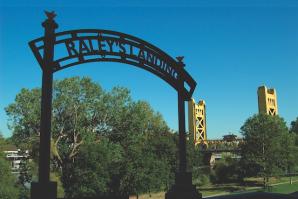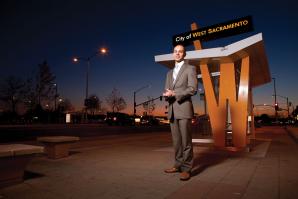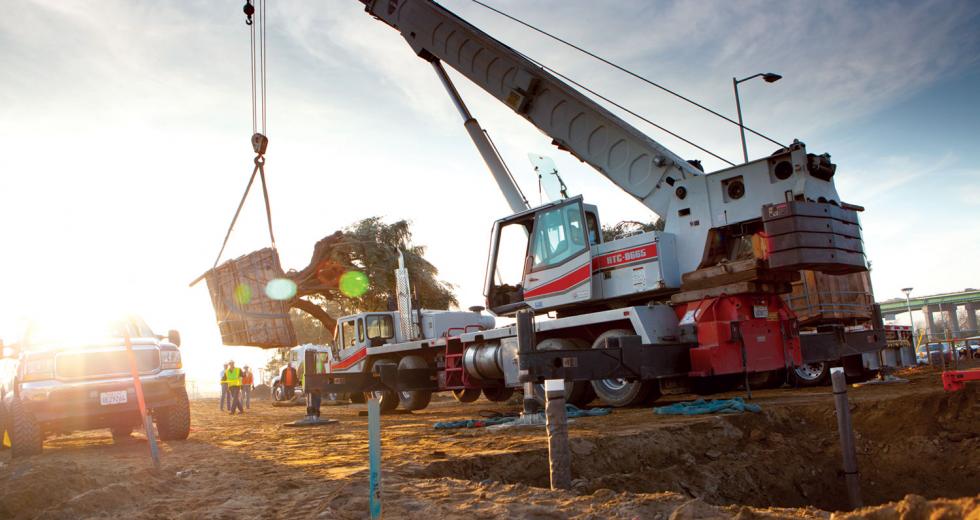On a breezy, blue-sky day in late November, West Sacramento city and regional planning officials gathered near Raley Field to celebrate the opening of Tower Bridge Gateway, a reconstructed boulevard connecting Highway 50 to Tower Bridge.
The project’s east phase converted a freeway onramp once known as State Route 275 into a four-lane road friendly to pedestrians, bikes and transit. Changes include wider sidewalks, traffic signals, a slower speed limit, wide bike lanes and a lane for a future streetcar.
The road once dividing the city now knits together several neighborhoods, including the Bridge District, a nascent, urban infill project to the south. The completion of Tower Bridge Gateway is one more accomplishment in the Bridge District’s formation.
City officials and the district’s property owners have been working for years to transform the former industrial area bordered by the Sacramento River, Tower Bridge Gateway and Highway 50. Although the district, which consists of about 90 developable acres, is still largely vacant, several key projects have recently been completed, are under way or are poised to start construction.
The creation of the Bridge District is part of a growing revival of cities nationwide, says John Norquist, president and CEO of the Chicago-based Congress for the New Urbanism. Changes in the real estate market and a desire to live in more interesting spaces are fueling a return to mixed-use urban areas, the norm before the post-World War II era ushered in suburban sprawl, he says.
It took years to overcome obstacles delaying construction in the Bridge District, including removing railroad tracks that cut off access to the river, revamping the foundational planning document and raising about $52 million to pay for infrastructure. Now, landowners say they are ready to build, but the market isn’t there.
A December state Supreme Court ruling allowing state lawmakers to dissolve redevelopment agencies could negatively impact the Bridge District, West Sacramento Mayor Christopher Cabaldon says. Redevelopment funds were a key part of the district’s public amenities financing plan, but the Legislature passed a bill last year that eliminated the agencies unless they pay a fee.
The ruling is “a blow to the Bridge District,” Cabaldon says.
First-phase Bridge District construction projects that have already been allocated to redevelopment funds before the ruling will move forward because it would be illegal to renege on those contracts, Cabaldon says. But second-phase, quality-of-life amenities, such as a public pier and a streetcar, were dependent on redevelopment funding. Now, the city must seek other sources.
Under the ruling, the city’s redevelopment agency will have to sell its land holdings, including Bridge District parcels. Cabaldon is concerned that speculators will purchase redevelopment-owned land needed for future infrastructure projects at reduced prices and sell it back to the city at exorbitant rates.
“There is a real danger of that sort of unfettered speculation having a gigantic cost to the taxpayers,” he says.
The redevelopment agency has protected itself in part by selling some of its Bridge District land to local property owners for specific projects. It also has put restrictions on some properties needed for future projects.
Still, the district’s major landowners say they are committed to building and are waiting for the market to turn around.
“The values that are the basis for all the decisions made are durable and can survive this market cycle,” says Stephen Jaycox, senior vice president of design and marketing at Fulcrum Property, which has development rights to 50 acres in the Bridge District.
The district is envisioned as a dense neighborhood with a minimum 50 units per acre, an antidote to sprawl and part of a regional strategy to direct growth away from farmland and sensitive habitat. It will be a mix of economically diverse apartments, condos and townhomes. Restaurants, shops, offices, parks, a waterfront plaza and other amenities would add to the allure.
Building in the Bridge District follows guidelines from the Leadership in Energy and Environmental Design (LEED) for Neighborhood Development program. The entire neighborhood, from the location of bus stops to the stormwater capture system, would adhere to sustainable design principles.
The tree-lined river will be the neighborhood’s defining element, with buildings, streets and parks designed to protect and showcase views and access. City officials and property owners say proximity to freeway onramps, downtown Sacramento and the Sacramento River — plus its orientation outside the flood zone — make the Bridge District an ideal location.
The city and property owners designed a plan with clear standards about development quality, sustainability, walkability and density that is “flexible enough to take advantage of interesting and creative (market) opportunities,” Cabaldon says. “We want it to be something that is unlike anything else in our region, but that also has a distinct Sacramento-region feel to it and is very comfortable and an easy place to live.”
“We want it to be something that is unlike anything else in our region, but that also has a distinct Sacramento-region feel to it and is very comfortable and an easy place to live.”
Christopher Cabaldon, mayor, city of West Sacramento
Several key projects have been completed in the Bridge District or are under way. The infrastructure is nearly done. Utility lines and roads, all designed to serve an expected build-out of 9.6 million square feet, are planned for completion by April.
Laying the infrastructure has transformed the district, “giving people a vision of what this neighborhood will be, which is essentially an extension of downtown Sacramento,” says Katy Jacobson, Bridge District manager for West Sacramento.
In October, the city finished building one phase of the River Walk Trail, a foot and bike path extending the existing path between the I Street Bridge and Tower Bridge along the Sacramento River to Mill Street. The $1.7 million project, a key feature of the district, gives residents legal access to the river for the first time in more than a century, Cabaldon says.
Fulcrum Property, which has development rights to the largest acreage in the district, started building Garden Park in October. Fulcrum is planning to build 120 rental apartments and 30 owner-occupied townhomes around the 28,000-square-foot neighborhood park when it’s completed later this year. It could pull building permits as early as the summer, market depending. This housing will help meet the requirements of the Proposition 1C grant used to partially fund construction of infrastructure throughout the district. Restaurants, retail, office space and more residential units could follow.
Bridge Housing Corp., a San Francisco-based affordable housing developer, also plans to start construction on rental apartments in the district this fall. Its $22 million, one-acre project would also help meet the Prop 1C infrastructure grant requirements.
As part of that project, Bridge Housing plans to build 70 apartments with monthly rents starting at $439 for tenants who earn less than 60 percent of Yolo County’s median income.
Two projects have been catalysts for further construction. Raley Field, a ballpark home to the Triple-A Sacramento River Cats that opened in 2000, brings visibility to the Bridge District by drawing more than 700,000 people annually to its games, concerts and other events. Ironworks, a Regis Homes of Sacramento subdivision in the district’s northwest corner, opened several years ago.
Mayor Cabaldon says the Bridge District and other urban developments will be where the bulk of the area’s growth occurs. “It’s one of our region’s strongest bets for long-term economic prosperity,” he says, “and I’m bullish on it.”
Family Planning
The Bridge District’s main property owners say they’d like to build now, but the market is too depressed. Mark Friedman, founder and president of Fulcrum Property, and the Savage family, owners of Raley Field and the Sacramento River Cats baseball team, jointly own 10 acres and have talked about building an entertainment district near the ballpark.
Dan Ramos, vice president of West Sacramento-based Ramco Enterprises Inc., with his family owns nearly six acres spread over two parcels. A 3.2-acre riverfront parcel next to Tower Bridge would be a mixed-use gateway project, perhaps consisting of a high-rise office building, a condo tower or hotel, or a mix of all three plus retail and restaurants. The family plans to build one or two office buildings in the district’s core on four acres with the Clark family, owners of Clark Pacific, an architectural precast concrete manufacturer in West Sacramento. Each family owns about two acres. Ramos hopes to lure one or more entities such as a state agency, a Silicon Valley social networking company or a local company.
The Unger family, whose patriarch was the late local architect Dean Unger, plans to build 100 market-rate riverfront apartments as a first project, according to Gregg Herrington, vice president of the Yackzan Group Inc., a Davis development and property management company owned by Unger’s daughter, Lynne Yackzan.
The units would help meet the housing requirement of the state’s Proposition 1C infrastructure grant. The company was costing out the project in December and, if financially sensible, would submit plans to the city in 2012, Herrington says.
Despite the sour economy and the potential loss of redevelopment funds, Herrington says, “The stars are aligned for this area … It’s got great owners, it’s in a great city, and it’s got the location and access. It’s prime.”
Recommended For You

What the Waterfront
The evolution of West Sac’s shoreline
As a resident of fabulous West Sacramento, I was going to start this column with my standard opening line of “West Sac is the best Sac,” but flipping through the pages of our July ’92 issue, I found a quote from Val Toppenberg that said, “Cross-river bashing is not productive.” What a fun-killer.

West Cap Renaissance
A fresh downtown on a road less traveled
West Capitol Avenue is looking pretty snazzy these days. Modern buildings with shiny, chrome lettering line clean, wide sidewalks. Newly planted trees lead to bright bus stops stylized with sculptured ‘W’s nearly 10 feet tall.



